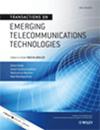A field study on the fusion of terrestrial and satellite location methods in urban cellular networks
引用次数: 5
Abstract
This work studies the improvement in service coverage obtained by three different approaches to combining two triangulation (terrestrial and satellite) location methods for cellular networks in an urban environment. The paper assumes that the terrestrial cellular network uses enhanced observed time difference (E-OTD) in 2G or observed time difference of arrival (OTDOA) in 3G, while the satellite GNSS uses the assisted global positioning system (A-GPS), but the analysis can be easily generalised to other triangulation methods. A straightforward analytical model is presented to evaluate the service coverage resulting from each of the three approaches. The model is fed with actual coverage figures, gathered from test measurements carried out in Paris (France) for several urban scenarios. Numerical results show that the three approaches lead to improvements in all the tested scenarios, and that the improvement obtained by the increasing complexity of the fusion approach depends highly on the coverage of each individual method and on the joint probability function of individual performances. Copyright © 2010 John Wiley & Sons, Ltd.城市蜂窝网络中地面与卫星定位方法融合的实地研究
这项工作研究了在城市环境中蜂窝网络通过三种不同的方法结合两种三角测量(地面和卫星)定位方法获得的服务覆盖的改进。本文假设地面蜂窝网络在2G中使用增强观测时差(E-OTD)或在3G中使用观测到达时差(OTDOA),而卫星GNSS使用辅助全球定位系统(A-GPS),但分析可以很容易地推广到其他三角测量方法。提出了一个简单的分析模型来评估这三种方法所产生的服务覆盖率。该模型采用了实际的覆盖数据,这些数据是从在巴黎(法国)进行的几个城市场景的测试测量中收集的。数值结果表明,这三种方法在所有测试场景下都有改进,并且随着融合方法复杂度的增加,所获得的改进在很大程度上取决于每种方法的覆盖范围和个体性能的联合概率函数。版权所有©2010 John Wiley & Sons, Ltd
本文章由计算机程序翻译,如有差异,请以英文原文为准。
求助全文
约1分钟内获得全文
求助全文

 求助内容:
求助内容: 应助结果提醒方式:
应助结果提醒方式:


